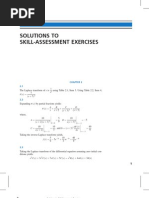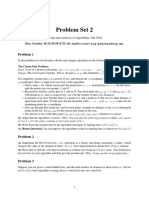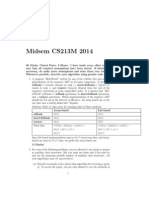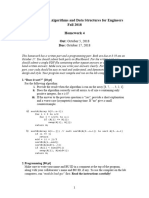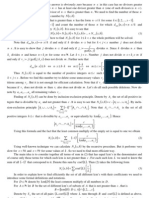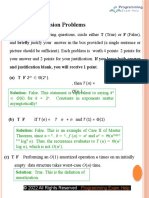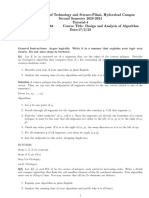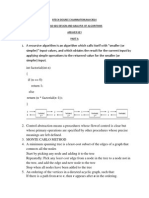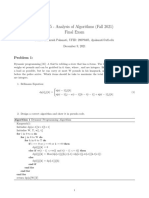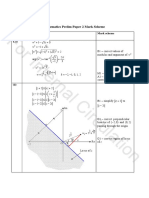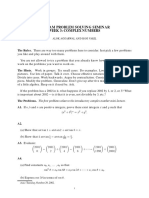dis02-sol
dis02-sol
Uploaded by
shiyuexuCopyright:
Available Formats
dis02-sol
dis02-sol
Uploaded by
shiyuexuCopyright
Available Formats
Share this document
Did you find this document useful?
Is this content inappropriate?
Copyright:
Available Formats
dis02-sol
dis02-sol
Uploaded by
shiyuexuCopyright:
Available Formats
CS 170, Fall 2024 Discussion 2 P. Raghavendra and S.
Garg
Note: Your TA probably will not cover all the problems. This is totally fine, the discussion worksheets
are deliberately made long so they can serve as a resource you can use to practice, reinforce, and build
upon concepts discussed in lecture, readings, and the homework.
1 Maximum Subarray Sum
Given an array A of n integers, the maximum subarray sum is the largest sum of any contiguous
subarray of A (including the empty subarray). In other words, the maximum subarray sum is:
j
X
max A[k]
i≤j
k=i
For example, the maximum subarray sum of [−2, 1, −3, 4, −1, 2, 1, −5, 4] is 6, the sum of the contiguous
subarray [4, −1, 2, 1].
(a) Design an O(n log n)-time divide-and-conquer algorithm that finds the maximum subarray sum.
Hint: Split the array into two equally-sized pieces. What are the types of possibilities for the
max subarray, and how does this apply if we want to use divide and conquer?
(b) Briefly justify the correctness of your algorithm.
Hint: Use induction!
(c) Prove that your algorithm runs in O(n log n).
This content is protected and may not be shared, uploaded, or distributed. 1 of 7
CS 170, Fall 2024 Discussion 2 P. Raghavendra and S. Garg
Solution:
(a) Main idea: At first glance it seems like we have to find two indices i an j such that the
subarray A[i : j] has sum as large as possible. There are n2 possibilities. However, there is a
divide and conquer solution: split A into two equal pieces , L and R, defined as A[1 : n/2] and
A[n/2 + 1 : n]. There are two options for the subarray with the largest sum:
(i) It is contained entirely in L or R: Solve by recursion. Let s1 be the result of recursively
calling the algorithm on L, and s2 be the result of recursively calling the algorithm on R.
(ii) It “crosses the boundary”, i.e. starts in L and ends in R: if the maximum subarray
runs from A[i : j], then A[i, n/2] must be the maximum subarray ending at A[n/2], and
A[n/2 + 1, j] must be the maximum subarray starting at A[n/2 + 1]. It might seem like
we must now solve two largest subarray sum problems: find i such that the subarray sum
A[i, n/2] is as large as possible. And same for A[n/2+1, j]. Note that each of these require
finding just one index i or j for which there are only n/2 possibilities each. So each can be
computed in O(n) steps. e.g. to find i, compute each successive subarray sum A[k, n/2]
for k = 1 to n/2 and take the maximum. Finally, let s3 be the sum of the elements in
A[i, n/2] plus the sum of the elements in A[n/2 + 1, j].
If n = 1, return max{A[1], 0}. Else return max{s1 , s2 , s3 }.
(b) Proof of correctness: We prove by induction. When the array is length 1, our algorithm is
clearly correct.
When the array is length at least 2, there are two options for the subarray with the largest sum:
(i) It is contained entirely in L or R.
(ii) It “crosses the boundary”, starts before element n/2 and ends after element n/2.
In the first case, either s1 or s2 is outputted by the algorithm, which we inductively assume is
correct.
To handle the second case, the maximum subarray sum crossing the boundary must consist of
the subarray with the largest sum ending in element n/2, and the subarray with the largest
sum beginning with element n/2 + 1. So s3 will be outputted by the algorithm in this case,
which is correct.
(c) Runtime analysis: Our method for computing s3 takes O(n) time, since each of the sums of
A[i : n/2] and A[n/2 + 1 : i] is computed in O(1) time given a previous sum. So we get the
recurrence:
T (n) = 2T (n/2) + O(n)
Using the Master theorem, this results in a runtime of O(n log n).
This content is protected and may not be shared, uploaded, or distributed. 2 of 7
CS 170, Fall 2024 Discussion 2 P. Raghavendra and S. Garg
2 Pareto Optimality
Given a set of points P = {(x1 , y1 ), (x2 , y2 ) . . . (xn , yn )}, a point (xi , yi ) ∈ P is Pareto-optimal if there
does not exist any j ̸= i such that such that xj > xi and yj > yi . In other words, there is no point in
P above and to the right of (xi , yi ).
(a) Design a O(n log n)-time divide-and-conquer algorithm that given P , outputs all Pareto-optimal
points in P .
Hint: Split the array by x-coordinate. Show that all points returned by one of the two recursive
calls is Pareto-optimal, and that you can get rid of all non-Pareto-optimal points in the other
recursive call in linear time.
(b) Analyze the runtime of your algorithm.
Solution:
Algorithm: Let L be the left half of the points when sorted by x-coordinate, and R be the right
half. Recurse on L and R, let L′ , R′ be the sets of Pareto-optimal points returned. We can compute
ymax , the largest y-coordinate in R, in a linear scan, and then remove all points in L′ with a smaller
y-coordinate. We then return the union of L′ , R′ .
Proof: We now prove the correctness of the algorithm on a sorted array of points. Note that in the
simplest case, there is only one point, which is by default Pareto-optimal. Now, say that there are
more than one points. Then, we can assume that L′ contains the points that are Pareto-optimal in
the set L and R′ contains the points that are Pareto-optimal in the set R. Every point in R′ is Pareto-
optimal in L ∪ R, since all points in L have smaller x-coordinates and can’t violate Pareto-optimality
of points in R′ . For each point in L′ , it’s Pareto-optimal in L ∪ R iff its y-coordinate is larger than
ymax , the largest y-coordinate in R. Hence, our algorithm returns a set that is Pareto-optimal in the
set L ∪ R.
Runtime: Using the master theorem, we can see this runs in T (n) = 2T (n/2) + O(n) = O(n log n)
time.
This content is protected and may not be shared, uploaded, or distributed. 3 of 7
CS 170, Fall 2024 Discussion 2 P. Raghavendra and S. Garg
3 Counting Inversions
This problem arises in the analysis of rankings. Consider comparing two rankings. One way is to
label the elements (books, movies, etc.) from 1 to k according to one of the rankings, then order these
labels according to the other ranking, and see how many pairs are “out of order”.
We are given a sequence of k distinct numbers n1 , · · · , nk . We say that two indices i < j form an
inversion if ni > nj , that is, if the two elements ni and nj are “out of order.”
(a) Provide a divide and conquer algorithm to determine the number of inversions in the sequence
n1 , · · · , nk in time O(k log k).
Hint: Modify merge sort to count during merging. For reference, we provide pseudocode for
merge sort below:
def merge_sort(A):
if len(A) == 1: return A
B = merge_sort(first half of A) # recurse on left
C = merge_sort(second half of A) # recurse on right
# perform merge
D = []
while not B.empty() and not C.empty():
if B.empty():
D.extend(C)
else if C.empty():
D.extend(B)
else if B[0] < C[0]:
D.append(B[0])
B.popleft()
else:
D.append(C[0])
C.popleft()
return D
(b) Analyze the runtime of your algorithm.
Solution:
(a) Main idea
There can be a quadratic number of inversions. So, our algorithm must determine the total
This content is protected and may not be shared, uploaded, or distributed. 4 of 7
CS 170, Fall 2024 Discussion 2 P. Raghavendra and S. Garg
count without looking at each inversion individually.
The idea is to modify merge sort. We split the sequence into two halves n1 , · · · , nl and
nl+1 , · · · , nk and count number of inversions in each half while sorting the two halves sepa-
rately. Then we count the number of inversions (ai , aj ), where two numbers belong to different
halves, while combining the two halves. The total count is the sum of these three counts.
(b) Psuedocode
procedure count(A)
if length[A] = 1 then
return A, 0
B, x ← count(first half of A)
C, y ← count(rest of A)
D ← empty list
z←0
while B is not empty or C is not empty do
if B is empty then
Append C to D and remove elements from C
else if C is empty then
Append B to D and remove elements from B
else if B[1] < C[1] then
Append B[1] to D and remove B[1] from B
else
Append C[1] to D and remove C[1] from C
z ← z+ length[B]
return D, x + y + z
(c) Proof of correctness Consider now a step in merging. Suppose the pointers are pointing at
elements bi and cj . Because B and C are sorted , if bi is appended to D, no new inversions are
encountered, since bi is smaller than everything left in list C, and it comes before all of them.
On the other hand, if cj is appended to D, then it is smaller than all the remaining elements
in B, and it comes after all of them, so we increase the count of inversions by the number of
elements remaining in B.
(d) Running time analysis In each recursive call, we merge the two sorted lists and count the
inversions in O(n). The running time is given by T (n) = 2T (n/2) + O(n) which is O(n log n)
by the master theorem.
This content is protected and may not be shared, uploaded, or distributed. 5 of 7
CS 170, Fall 2024 Discussion 2 P. Raghavendra and S. Garg
4 Monotone matrices
A m-by-n matrix A is monotone if n ≥ m, each row of A has no duplicate entries, and it has the
following property: if the minimum of row i is located at column ji , then j1 < j2 < j3 . . . jm . For
example, the following matrix is monotone (the minimum of each row is bolded):
1 3 4 6 5 2
7 3 2 5 6 4
7 9 6 3 10 0
(a) Give an efficient (i.e., better than O(mn)-time) algorithm that finds the minimum in each row
of an m-by-n monotone matrix A.
Hint: monotonicity suggests that a binary-search-esque approach may be effective.
(b) Provide a brief proof of correctness.
Hint; use induction!
(c) Analyze the runtime of your algorithm. You do not need to write a formal recurrence relation;
an informal summary is fine.
Challenge: rigorously analyze the runtime via solving a recurrence relation using
the subproblem T (m, n).
This content is protected and may not be shared, uploaded, or distributed. 6 of 7
CS 170, Fall 2024 Discussion 2 P. Raghavendra and S. Garg
Solution:
(i) Main idea: If A has one row, we just scan that row and output its minimum.
Otherwise, we find the smallest entry of the m/2-th row of A by just scanning the row. If this
entry is located at column j, then since A is a monotone matrix, the minimum for all rows above
the m/2-th row must be located to the left of the j-th column. i.e. in the submatrix formed by
rows 1 to m/2 − 1 and columns 1 to j − 1 of A, which we will denote by A[1 : m/2 − 1, 1 : j − 1].
Similarly, the minimum for all rows below the m/2-th row must be located to the right of the
j-th column. So we can recursively call the algorithm on the submatrices A[1 : m/2−1, 1 : j −1]
and A[m/2 + 1 : m, j + 1 : n] to find and output the minima for rows 1 to m/2 − 1 and rows
m/2 + 1 to m.
(ii) Proof of correctness: We will prove correctness by (total) induction on m.
As a base case, m = 1, and the algorithm explicitly finds and outputs the minimum of the single
row.
If A has more than one row, we of course find and output the correct row minimum for row
m/2. As argued above, the minima of rows 1 to m/2 − 1 of A are the same as the minima of the
submatrix A[1 : m/2 − 1, 1 : j − 1], and the minima of rows m/2 + 1 to m are the same as the
minima of the submatrix A[m/2 + 1 : m, j + 1 : n]. By the induction hypothesis, the algorithm
correctly outputs the minima of these matrices, and together with the m/2 row above, they
find and output the minima of all the rows of A.
(iii) Running time analysis: There are two ways to analyze the run time. One involves doing an
explicit accounting of the total number of steps at each level of the recursion, as we did before
we relied on the master theorem, or as we did in the proof of the master theorem. Since m is
halved at each step of recursion, there are log m levels of recursion. At each level of recursion,
the number of columns of the matrix get split into two – those associated with the left matrix
and those associated with the right matrix. Moreover, the number of steps required to perform
the split is just n, since it involves scanning all the entries of a single row. This means that at
any level of the recursion, all the submatrices
P have disjoint columns, meaning if the different
submatrices have nk columns, then k nk ≤ n. The total number P of steps required to split
these matrices to go to the next level of recursion is then just k nk ≤ n. So there are log m
levels of recursion, each taking total time n, for a grand total of n log m.
Actually to be more accurate, when m=1, log m = 0, so the expression should be n(log m + 1)
to get the base case right.
Another way to analyze the running time is by writing and solving a recurrence relation (though
again, this isn’t necessary for full credit). The recurrence is easy to write out: let T (m, n) be
the number of steps to solve the problem for an m × n array. It takes n time to find the
minimum of row m/2. If this row has minimum at column j, we recurse on submatrices of
size at most m/2-by-j and m/2-by-(n − j). So we can write the following recurrence relation:
T (m, n) ≤ T (m/2, j) + T (m/2, n − j) + n.
This does not directly look the recurrences in the master theorem — it is “2-D” since it depends
upon two variables. You need some inspiration to guess the solution. We will guess that
T (m, n) ≤ n(log m + 1). We can prove this by strong induction on m.
Base case: T (1, n) = n = n(log 1 + 1).
Induction step:
T (m, n) ≤ T (m/2, j) + T (m/2, n − j) + n ≤ j(log(m/2) + 1) + (n − j)(log(m/2) + 1) + n
(by the induction hypothesis)
= n(log(m/2) + 1 + 1) = n(log m + 1).
This content is protected and may not be shared, uploaded, or distributed. 7 of 7
You might also like
- HW3 SolDocument4 pagesHW3 SolharshNo ratings yet
- Solution of Skill Assesment Exercise of Control System Engineering by Norman S NiseDocument53 pagesSolution of Skill Assesment Exercise of Control System Engineering by Norman S NiseCarraan Dandeettirra Caala Altakkatakka75% (8)
- Problem Set 1Document13 pagesProblem Set 1redNo ratings yet
- Problem Set #1. Due Sept. 9 2020.: MAE 501 - Fall 2020. Luc Deike, Anastasia Bizyaeva, Jiarong Wu September 2, 2020Document3 pagesProblem Set #1. Due Sept. 9 2020.: MAE 501 - Fall 2020. Luc Deike, Anastasia Bizyaeva, Jiarong Wu September 2, 2020Francisco SáenzNo ratings yet
- Problem by David MountDocument28 pagesProblem by David Mountdineshdash1979No ratings yet
- Dimensional Engineering: GM General Motors Truck GroupDocument97 pagesDimensional Engineering: GM General Motors Truck Groupdramilt100% (1)
- ps2Document3 pagesps2sunshiyao0No ratings yet
- AD I Practice QuestionsDocument11 pagesAD I Practice QuestionsV KumarNo ratings yet
- 002 DcproblemsDocument8 pages002 DcproblemsTayyab UsmanNo ratings yet
- Mathematical Tripos: at The End of The ExaminationDocument27 pagesMathematical Tripos: at The End of The ExaminationDedliNo ratings yet
- CSF211 2024 MidsemSolutionsDocument6 pagesCSF211 2024 MidsemSolutionsDIY HJ HACKSNo ratings yet
- Lec3 Algo2021SpringDocument13 pagesLec3 Algo2021SpringDavid Esteban Martin AcostaNo ratings yet
- Practice Sheet Divide and ConquerDocument5 pagesPractice Sheet Divide and ConquerApoorva GuptaNo ratings yet
- MidsemDocument6 pagesMidsemAravind SomasundaramNo ratings yet
- AMATH301 Homework3 Writeup SolutionsDocument8 pagesAMATH301 Homework3 Writeup SolutionsJordan HuangNo ratings yet
- EC330 Applied Algorithms and Data Structures For Engineers Fall 2018 Homework 4Document3 pagesEC330 Applied Algorithms and Data Structures For Engineers Fall 2018 Homework 4DF QWERTNo ratings yet
- COMP90038 2022S1 A1 SolutionsDocument4 pagesCOMP90038 2022S1 A1 Solutionsfrancisco realesNo ratings yet
- 0.1 Worst and Best Case AnalysisDocument6 pages0.1 Worst and Best Case Analysisshashank dwivediNo ratings yet
- Experiment No.02: Part ADocument7 pagesExperiment No.02: Part AanushkaNo ratings yet
- 1 SolnsDocument3 pages1 Solnsiasi2050No ratings yet
- ('Christos Papadimitriou', 'Final', ' (Solution) ') Fall 2009Document7 pages('Christos Papadimitriou', 'Final', ' (Solution) ') Fall 2009John SmithNo ratings yet
- Sample Questions 2020 Test Code PCB (Short Answer Type)Document12 pagesSample Questions 2020 Test Code PCB (Short Answer Type)Rishu SnNo ratings yet
- HW 04 ExtraDocument5 pagesHW 04 ExtraDavid Esteban Martin AcostaNo ratings yet
- Assignment MEF 1 2018Document5 pagesAssignment MEF 1 2018rtchuidjangnanaNo ratings yet
- Test 1 Review and Practice QuestionsDocument7 pagesTest 1 Review and Practice QuestionselsainetedelautrecNo ratings yet
- HuvaagchDocument3 pagesHuvaagchDulguun BatmonhNo ratings yet
- DAA3Document9 pagesDAA3GOURAV MISHRANo ratings yet
- VincentDocument130 pagesVincentOmaar Mustaine RattleheadNo ratings yet
- MollinDocument72 pagesMollinPhúc NguyễnNo ratings yet
- 20MCA023 Algorithm AssighnmentDocument13 pages20MCA023 Algorithm AssighnmentPratik KakaniNo ratings yet
- pr1 Soln PDFDocument6 pagespr1 Soln PDFRahulNo ratings yet
- Final Term Test Soln 2020Document9 pagesFinal Term Test Soln 2020Sourabh RajNo ratings yet
- CSCI570 - Fall2024 HW3 Sep29Document4 pagesCSCI570 - Fall2024 HW3 Sep29Pranav PandyNo ratings yet
- GATE OverflowDocument485 pagesGATE Overflowlokenders801No ratings yet
- Sorting in Linear Time: Counting-SortDocument7 pagesSorting in Linear Time: Counting-Sortcristi_pet4742No ratings yet
- Cg1 Assignment 2 TransformDocument7 pagesCg1 Assignment 2 Transformadam johnNo ratings yet
- Ae Chapter2 MathDocument44 pagesAe Chapter2 MathjruanNo ratings yet
- Algorithm Exam HelpDocument17 pagesAlgorithm Exam HelpProgramming Exam HelpNo ratings yet
- Tut 4 SolutionsDocument2 pagesTut 4 Solutionsarunachala.gamingNo ratings yet
- Lec 5Document5 pagesLec 5Sake AnilaNo ratings yet
- 8694Lab Manual EXPT No. 2 AOA - Merge SortDocument9 pages8694Lab Manual EXPT No. 2 AOA - Merge SortdanishNo ratings yet
- The Fundamentals: Algorithms The IntegersDocument55 pagesThe Fundamentals: Algorithms The Integersnguyên trần minhNo ratings yet
- 1 Counting SortDocument8 pages1 Counting SortLucas NáiadeNo ratings yet
- B036-Expt No.2 AoaDocument12 pagesB036-Expt No.2 Aoamaheshbhosale1212004No ratings yet
- Final 13Document9 pagesFinal 13نورالدين بوجناحNo ratings yet
- Tut2 SolDocument4 pagesTut2 SolSnigdhoneel BiswasNo ratings yet
- Btech Degree Examination, May2014 Cs010 601 Design and Analysis of Algorithms Answer Key Part-A 1Document14 pagesBtech Degree Examination, May2014 Cs010 601 Design and Analysis of Algorithms Answer Key Part-A 1kalaraijuNo ratings yet
- 1-Divide and Conquer AlgorithmsDocument99 pages1-Divide and Conquer AlgorithmsShivani SrivastavaNo ratings yet
- Constructive Mathematics NotesDocument25 pagesConstructive Mathematics NotesChandan GuptaNo ratings yet
- Algorithm Homework HelpDocument17 pagesAlgorithm Homework HelpProgramming Homework HelpNo ratings yet
- Ad3351 Daa Ass-II QB Edited 8.11.2024Document76 pagesAd3351 Daa Ass-II QB Edited 8.11.2024Tamil KNo ratings yet
- Tutorial 1, Design and Analysis of Algorithms, 2024Document2 pagesTutorial 1, Design and Analysis of Algorithms, 2024abhishek.mishraNo ratings yet
- Final Exam: 1. Lots of Ones (20 Points)Document4 pagesFinal Exam: 1. Lots of Ones (20 Points)FidaHussainNo ratings yet
- COT5405 - Analysis of Algorithms (Fall 2021) Final Exam: Problem 1Document5 pagesCOT5405 - Analysis of Algorithms (Fall 2021) Final Exam: Problem 1Dhanush PakanatiNo ratings yet
- Problem Set 2: InstructionsDocument4 pagesProblem Set 2: InstructionsballechaseNo ratings yet
- Midterm SolutionDocument11 pagesMidterm SolutionAndrés López MartínezNo ratings yet
- Numerical Linear Algebra University of Edinburgh Past Paper 2019-2020Document5 pagesNumerical Linear Algebra University of Edinburgh Past Paper 2019-2020Jonathan SamuelsNo ratings yet
- CSCI 3110 Assignment 6 Solutions: December 5, 2012Document5 pagesCSCI 3110 Assignment 6 Solutions: December 5, 2012AdamNo ratings yet
- Clustering With Gradient Descent: 1 PerformanceDocument4 pagesClustering With Gradient Descent: 1 PerformanceChristine StraubNo ratings yet
- A-level Maths Revision: Cheeky Revision ShortcutsFrom EverandA-level Maths Revision: Cheeky Revision ShortcutsRating: 3.5 out of 5 stars3.5/5 (8)
- Limits of Accuracy: This Chapter Will Show YouDocument12 pagesLimits of Accuracy: This Chapter Will Show Youqarree100% (1)
- 2013 HCI Prelim Paper 2 Mark SchemeDocument13 pages2013 HCI Prelim Paper 2 Mark SchemeYan Shen TanNo ratings yet
- 81 Poly ShapeDocument2 pages81 Poly ShapeAlexis JNo ratings yet
- Ai Fundamentals Prelim ExamDocument109 pagesAi Fundamentals Prelim Exammrym shuttfupNo ratings yet
- Unit 6 The Mathematics of Graphs Part 3Document8 pagesUnit 6 The Mathematics of Graphs Part 3Jennilyn ConcepcionNo ratings yet
- Ec 1361 - Digital Signal ProcessingDocument16 pagesEc 1361 - Digital Signal ProcessingEleazar PaclibarNo ratings yet
- Holdman 2day Pbi Lesson-2Document44 pagesHoldman 2day Pbi Lesson-2api-210118947No ratings yet
- Familiarization: Dirac Delta FunctionDocument4 pagesFamiliarization: Dirac Delta FunctionAli Hassan RazaNo ratings yet
- SASMO Grade 7 (Secondary 1) Sample QuestionsDocument5 pagesSASMO Grade 7 (Secondary 1) Sample QuestionsBen JohnsonNo ratings yet
- Putnam Problem Solving Seminar Week 3: Complex Numbers: The RulesDocument4 pagesPutnam Problem Solving Seminar Week 3: Complex Numbers: The RulesHicham ElyassamiNo ratings yet
- Lesson Proper - Module 5: Definite IntegralDocument25 pagesLesson Proper - Module 5: Definite IntegralJack NapierNo ratings yet
- Assignment 8Document4 pagesAssignment 8Jaswinder BrarNo ratings yet
- Unit 4 Inverse, Exponential, and Logarithmic FunctionsDocument25 pagesUnit 4 Inverse, Exponential, and Logarithmic FunctionsYhen Khoolet LabszxyouNo ratings yet
- A Quillen Model Structure For Chu Spaces: Jeffrey M. EggerDocument17 pagesA Quillen Model Structure For Chu Spaces: Jeffrey M. EggerwrdoNo ratings yet
- Real Life Application Examples On Set Theory Equivalence Relation Partition Function Properties of Integers Modular ArithmeticDocument7 pagesReal Life Application Examples On Set Theory Equivalence Relation Partition Function Properties of Integers Modular Arithmeticchristopher palacioNo ratings yet
- Problem and Solution Electric FieldDocument10 pagesProblem and Solution Electric FieldSansen Diamante Colipano Jr.No ratings yet
- 01 Matlab BasicsDocument20 pages01 Matlab BasicsOmed GharebNo ratings yet
- TestDocument3 pagesTestManu VermaNo ratings yet
- Loops in RDocument3 pagesLoops in RNilam PathareNo ratings yet
- Statistical Physics Year 3 - PHYS3002 Q and ADocument3 pagesStatistical Physics Year 3 - PHYS3002 Q and ASaraNo ratings yet
- Applied Mathematics Paper 2Document475 pagesApplied Mathematics Paper 2muwanguziebenezarNo ratings yet
- CLEPEquiv17 18Document1 pageCLEPEquiv17 18Roger McnabNo ratings yet
- 4MA1H November 2020 QP 4Document28 pages4MA1H November 2020 QP 4jackNo ratings yet
- Mathematics (Syllabus 4052) : Singapore-Cambridge General Certificate of Education Ordinary Level (2023)Document17 pagesMathematics (Syllabus 4052) : Singapore-Cambridge General Certificate of Education Ordinary Level (2023)Po ToNo ratings yet
- Scientific Notation Powerpoint PDFDocument18 pagesScientific Notation Powerpoint PDFKatheeja MusatheekNo ratings yet
- CVVC Complex IntegrationDocument21 pagesCVVC Complex IntegrationS AdilakshmiNo ratings yet
- Amendel SolDocument12 pagesAmendel SolChecozNo ratings yet
- Outlines of Compulsory Subjects PMS 2016Document5 pagesOutlines of Compulsory Subjects PMS 2016AmnaNo ratings yet

